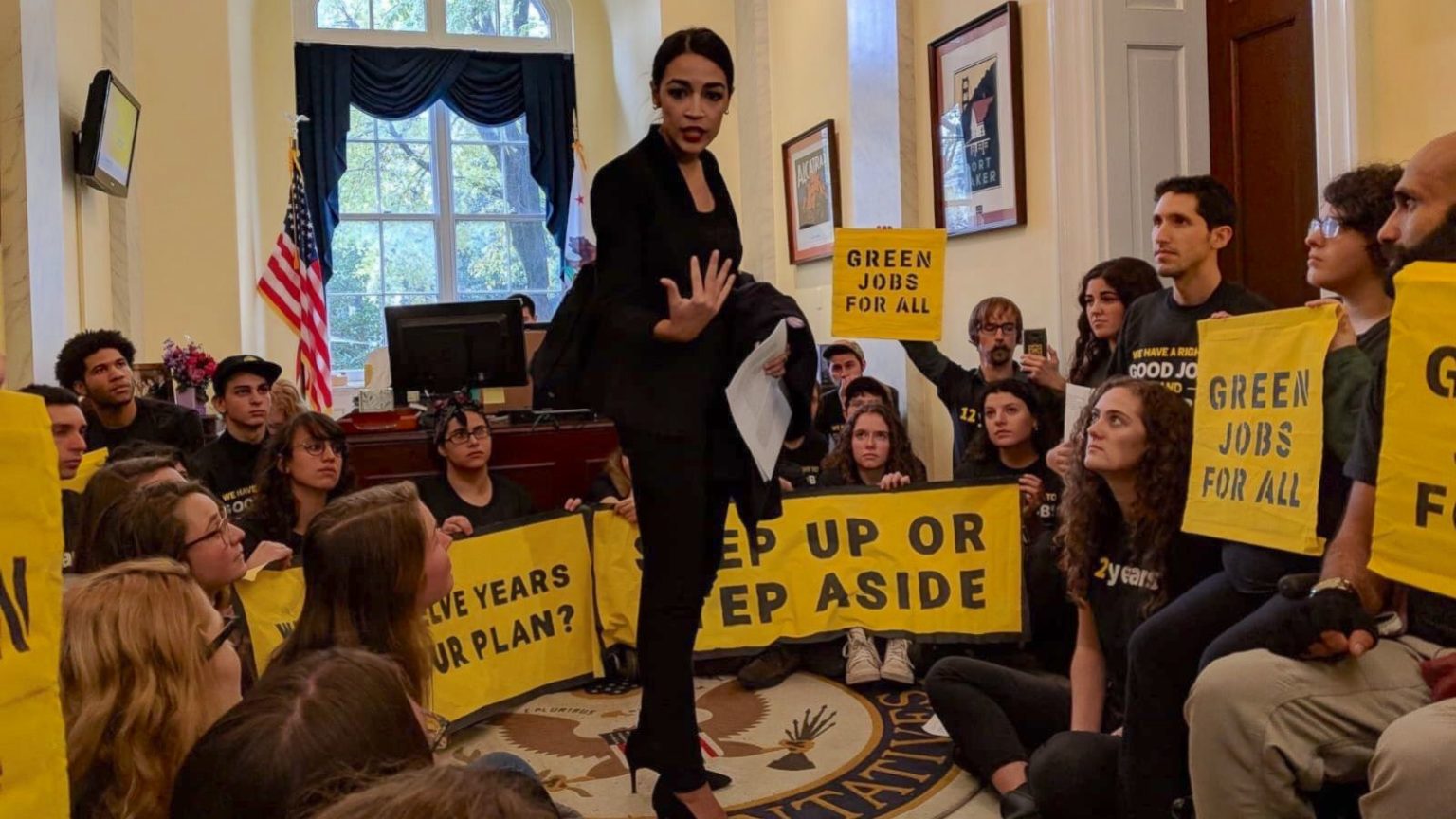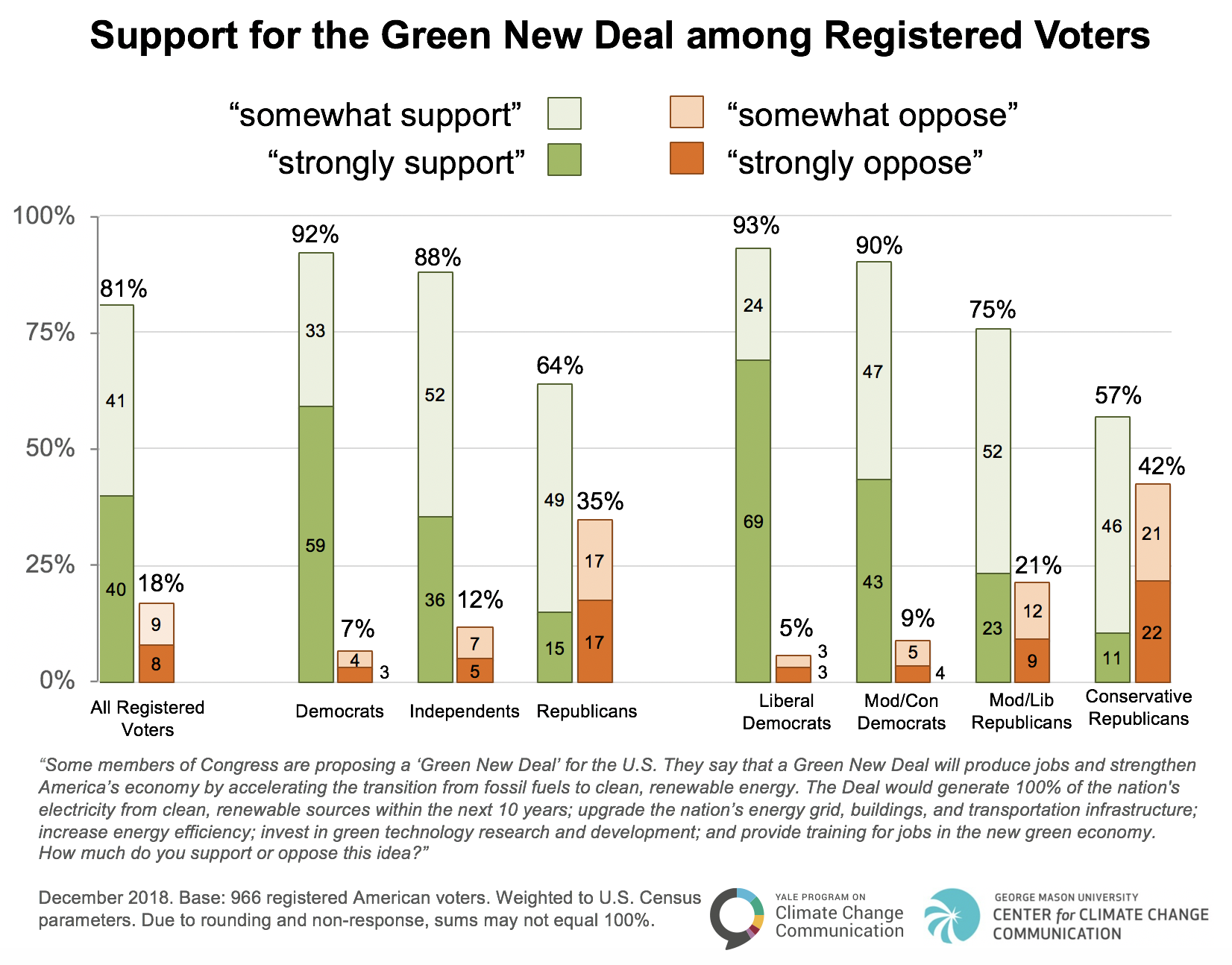A version of the Green New Deal (GND) — an FDR-style plan to address climate change by shifting America to a just and renewably powered 21st century economy — is widely popular with American voters of both parties, according to a recent survey.
Perhaps unsurprisingly, this proposal has stronger support among Democrats but still polls well with Republicans. The survey found that 81 percent of registered voters said they either “strongly support” or “somewhat support” a rapid transition to 100 percent renewable electricity and other green technology initiatives.
However, the poll, conducted by the Yale Program on Climate Change Communication (YCCC), also found that very few voters were aware of the Green New Deal: 82 percent said they “knew nothing” of the proposal. Notably, the poll’s language focused on renewable electricity and job creation, but made no mention of the full decarbonization and social overhaul of the American economy that also are central tenets of the full Green New Deal.
Credit: Yale Program on Climate Change Communication and George Mason University.
In reporting the results, the YCCC noted the likelihood that once Republican voters became aware that the Green New Deal is being championed by Democrats, their support for the idea will decrease. This survey asked respondents about support for some of the basic concepts of the Green New Deal without associating it with either major political party.
Even though polls have shown that the majority of Republicans believe in climate change, research shows that if a proposal is made by the Democrats, Republican voters are less likely to support it. The same was true of Democratic voters and proposals made by Republicans.
Naturally, climate deniers and right-wing media like Fox News and The New York Post already are attacking the concept and its most visible champion, Rep. Alexandria Ocasio-Cortez (D-NY), foreshadowing the GND‘s slide into the partisan.
What Exactly Is the Green New Deal?
Many in the climate and energy media sphere already have attempted to pin down what exactly the Green New Deal is and how it came to be, with David Roberts at Vox going deep and long, and Tim Dickinson at Rolling Stone diving in this week because “The Green New Deal is suddenly on everyone’s lips.”
In the Yale survey, however, respondents were told that members of Congress say the Green New Deal “will produce jobs and strengthen America’s economy by accelerating the transition from fossil fuels to clean, renewable energy.”
Survey respondents were given some specifics for how this would be accomplished, which included generating 100 percent of America’s electricity from renewable sources within 10 years, upgrading the nation’s energy grid, focusing on energy efficiency, and training for jobs in the new green economy.
While this is a good general description of the GND, there is much more detail in a draft bill from Rep. Ocasio-Cortez, which even has an FAQ section.
Many people ask what a Green New Deal entails.
We are calling for a wartime-level, just economic mobilization plan to get to 100% renewable energy ASAP.
To read more, check out https://t.co/kzlXUIk0Dg – that’s our resolution text. Read Section #6 for our detailed scope & scale.
— Alexandria Ocasio-Cortez (@AOC) January 2, 2019
To say that the goals outlined in the GND are ambitious would be an understatement.
Additionally, Rep. Ocasio-Cortez told 60 minutes that funding for the GND could come from returning to much higher taxes (say up to 60 or 70 percent) on those making more than $10 million a year — something that certainly got the media’s attention.
Without a doubt, the proposed GND has brought the conversation about solutions for addressing the climate crisis into the mainstream media and will likely force the issue to become a much bigger player in the 2020 elections.
2020 Elections and the Green New Deal
The latest iteration of the Green New Deal was catapaulted to national attention by the Sunrise Movement — a relatively new, youth-led climate activist group. Despite only forming in the past two years, the Sunrise Movement was involved in the 2018 midterm elections and mobilized voters to help elect a number of new climate-focused candidates to Congress — most notably the upstart Ocasio-Cortez.
Soon after those electoral victories, the Sunrise Movement was pushing for a Green New Deal with demonstrations outside the office of soon-to-be Speaker of the House Rep. Nancy Pelosi (D-CA), with Ocasio-Cortez stopping by one sit-in to show support. It didn’t take long for the GND to become a litmus test for potential Democratic candidates for president.
Sen. Elizabeth Warren (D-MA) is the first Democrat to officially announce plans to run for president in 2020, and she and her staff quickly made clear she supports the Green New Deal.
NEW: Elizabeth Warren supports the idea for a “Green New Deal” — a sweeping climate framework being championed by Alexandria Ocasio-Cortez. https://t.co/bAqAcrN8a6
— Axios (@axios) January 2, 2019
Rep. Beto O’Rourke (D-TX), a likely candidate for president after his near-upset against Sen. Ted Cruz, also has expressed support for the GND concept but certainly has not embraced it yet. O’Rourke recently has been criticized for taking donations from the oil and gas industry.
Discussions of climate change in the last presidential election were almost non-existent, which shows just how drastically expectations on the topic already have shifted for politicians today.
“I am thrilled to see so many of the potential 2020 presidential candidates embracing the idea of a Green New Deal,” Ocasio-Cortez told CNN. “The oil and gas lobbyists won’t back down without a fight and that’s why we need to support groups like Sunrise Movement in their efforts to keep the pressure up.”
Meanwhile, human pressure on the climate itself continues to build, with the recent news that U.S. carbon emissions grew 3.4 percent in 2018, mostly due to the growing economy, which, the Green New Deal’s proponents might suggest, doesn’t have to be tied to fossil fuels.
Main image: Rep. Alexandria Ocasio-Cortez thanks protesters at a Sunrise Movement Green New Deal sit-in on Capitol Hill. Credit: Courtesy of the Sunrise Movement
Subscribe to our newsletter
Stay up to date with DeSmog news and alerts







